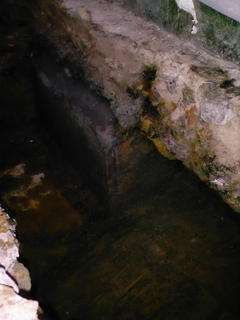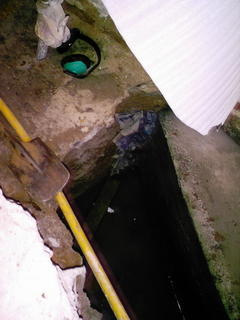

4000.
That's according to the Beatles, and I think they were comparing it to Blackburn, Lancashire. So we finally get around to the subject of holes. We've seen quite a few buildings go up, but here lies the secret of a good building. Firm foundations. Many of the jobs I undertake are to support buildings that have begun to move, this picture shows (and not very clearly, but squint and persevere) a 1.5m deep concrete slab, or 'pin', sitting under a 450mm wide brick footing, a footing is where the bricks of the wall are splayed out, usually in three or four courses, to help spread the loads that are transferred down the wall from the floors and the roof above it, onto the soil below. In this case it is onto clay. London Clay is one of the better soils for small buildings to bear onto, it is very firm, and usually to a 3m depth. Of course modern design would not be satisfied with a three storey building bearing on such shallow footings, here they are about 500mm below the level of the external ground. The wall has been moving because of an underground stream washing the clay away from under the wall, so an excavation of the clay is undertaken, in this case 1.7m deep by 600mm wide, the sides and the bottom of the pit are cleaned up, brushed down of any debris and the void is mass filled with concrete. Once this section is set, the next pin is excavated, jointed to the previous pin, and poured.



No comments:
Post a Comment